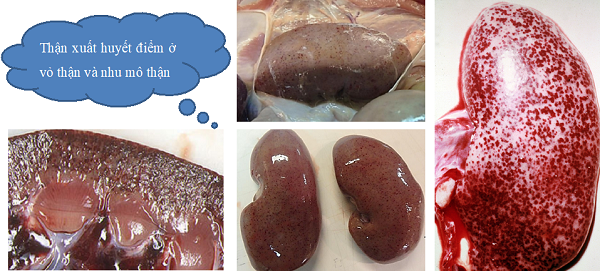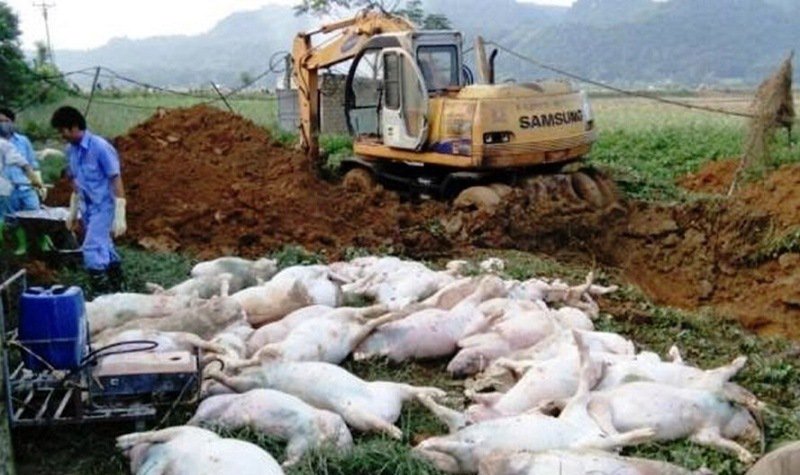African swine fever has spread to 34 provinces
African swine fever continues to spread across the country rapidly. Until now, African swine fever has spread to 34 provinces and cities across the country, with the number of culling about 1.5 million heads, accounting for 5% of the total number of pigs nationwide.
1. A brief overview of African swine fever
This is an infectious disease caused by a DNA-containing Myxovirus. When the disease occurs, it is easy to become epidemic and linger for many years. African swine fever has many levels of manifestations: acute, chronic, subacute and atypical. When pigs get sick, the mortality rate is 100%. The disease has characteristic signs such as skin bruising in most of the pig's body, widespread hemorrhagic inflammation in the gastrointestinal tract, lymph nodes and kidneys. African swine fever virus has a very good viability: they can live in blood for 6 years under cold storage conditions, in spleen for 2 - 2.5 years, in wet feces for 122 days, in urine for up to 2 years. 45 days. This virus is sensitive to disinfectants: NaOH 3 - 4%, Formol 2% and disinfectants for barns.
2. Characteristics of African swine fever
Both domestic and wild boar get the disease. Free-range pigs are more susceptible to disease due to their greater exposure to feces and urine. The disease can occur year round. Pigs of all ages can get sick.

Lợn nuôi thả rông dễ mắc bệnh tả lợn Châu Phi hơn
3. Manifestations of African swine fever
The incubation period is usually 5-10 days. Pigs have a fever as high as 41 - 42 degrees Celsius, the fever lasts continuously for about 4 days with normal health. After a period of fever, pigs show signs of lethargy, moodiness, weakness, shortness of breath, cough, tremor, unsteady gait, lying on top of each other, and miscarriage. Hemorrhagic bruises appear in the ears, abdomen, groin, posterior thighs and legs and then necrosis.
4. Lesions of African swine fever
There is blood coming out from natural openings such as mouth, nose, anus. Hemorrhage in the heart, myocardium, coronary heart. Spleen was enlarged, hemorrhagic, and infarcted. The liver is also enlarged and bleeding. The pig's lungs were bleeding, and the trachea and bronchi contained foam. The stomach is also bleeding. Hemorrhagic kidney.

Thận của lợn bị bệnh tả lợn Châu Phi bị xuất huyết
Bladder swelling and bleeding. The lymph nodes are swollen and hemorrhagic.
5. Has African swine fever ended?

Dịch tả lợn Châu Phi đã chấm dứt chưa?
In fact, if the prevention is not done thoroughly, it is possible for the disease to spread throughout the country, even in places where the epidemic is over, the disease can still return. The current situation is extremely urgent and complicated, not only small business households but also large livestock owners are affected. Swine cholera was recorded from Hung Yen and spread throughout the northern provinces.
African swine fever is a dangerous infectious disease caused by a virus, and spreads quickly. Although the disease is not contagious and causes disease in humans, the damage it causes is not small.
With the current complicated situation, households as well as leaders need to be drastic in how to handle the disease, and at the same time provide timely support to the affected households.
With the characteristics of pig farming in Vietnam with 2.5 million pig-raising households, plus the characteristics of the disease (the virus has high resistance, diverse transmission routes and no treatment), it should be taken into account when At this point, African swine fever was present in 34 provinces and cities across the country, up to 1.5 million pig herds had to be destroyed.
6. How to prevent African swine fever effectively
Breeding households need to strengthen disinfection of the barn both outside and inside the barn, the entrance to the farm, the place where the weighing vehicle is carried out, the area around the farm, the dead pig handling area,... At the gate Cattle entry and exit gates need to have disinfection pits and disinfectant sprayers, each farm head must always have a disinfecting pit/tray and daily water change. Vehicles entering and leaving the farm such as bran trucks, pig-catching trucks, 2-wheelers, etc. need to be sprayed with disinfectant before entering and leaving the farm. Staff should be restricted from leaving the camp unnecessarily. At the same time, it is necessary to limit the number of people entering the camp, when entering, they must go through a disinfecting house, shower with soap and need to be isolated for at least 24 hours, then they can go to the camp. Breeders need to take better care of their pigs, prevent diseases with vaccines for viral diseases such as: Blue ear, Cholera, Fake rabies, Foot-and-mouth disease, Circovirus,... Enhance resistance for pigs by adding vitamin C, vitamins of group B, Beta glucan,... Farmers need to import pigs of clear origin, and need to have a separate area to raise newly imported pigs in isolation, for monitoring. Right process. It is necessary to monitor the health status of the whole herd on a daily basis, thereby providing timely solutions if there is a suspicion of this disease. It is necessary to have measures to kill insects and rats in livestock farms. Do not allow cats, dogs, chickens and ducks inside the pig farm. African swine fever appeared in our country in early February in Hung Yen, then spread quickly to 34 provinces and cities across the country and has not ended. All people, especially large livestock farmers, need to pay attention to the prevention of this disease.
Để đặt lịch khám tại viện, Quý khách vui lòng bấm số HOTLINE hoặc đặt lịch trực tiếp TẠI ĐÂY. Tải và đặt lịch khám tự động trên ứng dụng MyVinmec để quản lý, theo dõi lịch và đặt hẹn mọi lúc mọi nơi ngay trên ứng dụng.
Bài viết này được viết cho người đọc tại Sài Gòn, Hà Nội, Hồ Chí Minh, Phú Quốc, Nha Trang, Hạ Long, Hải Phòng, Đà Nẵng.






